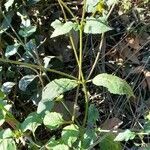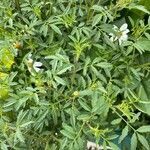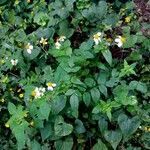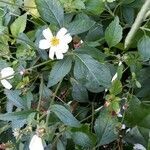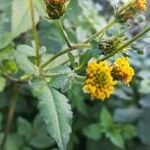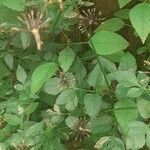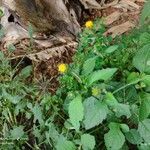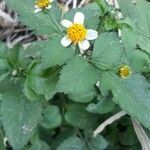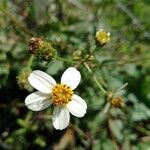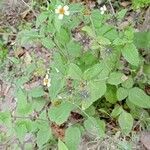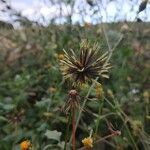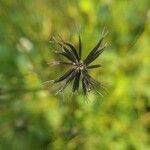Annuals. Stems 30-180 cm tall, glabrous or very sparsely pubescent in upper part. Petiole 10-30(-70) mm; leaf blade either ovate to lanceolate, 30-70(-120) × 12-18(-45) mm, or pinnately 1-lobed, primary lobes 3-7, ovate to lanceolate, (10-)25-80 × (5-)10-40 mm, both surfaces pilosulose to sparsely hirtellous or glabrate, bases truncate to cuneate, ultimate margin serrate or entire, usually ciliate, apices acute to attenuate. Synflorescence of solitary capitula or capitula in lax corymbs. Capitula radiate or discoid; peduncles 10-20(-90) mm; calycular bracts (6 or)7-9(-13), appressed, spatulate to linear, (3-)4-5 mm, abaxially usually hispidulous to puberulent, margins ciliate; involucres turbinate to campanulate, 5-6 × 6-8 mm; phyllaries (7 or)8 or 9(-13), lanceolate to oblanceolate, 4-6 mm. Ray florets absent or (3-)5-8; lamina whitish to pinkish, 5-15 mm. Disk florets 20-40(-80); corollas yellowish, (2-)3-5 mm. Outer achenes red-brown, ± flat, linear to narrowly cuneate, (3-)4-5 mm, faces obscurely 2-grooved, sometimes tuberculate-hispidulous, margin antrorsely hispidulous, apex truncate or somewhat attenuate; inner achenes blackish, ± equally 4-angled, linear-fusiform, 7-16 mm, faces 2-grooved, tuberculate-hispidulous to sparsely strigillose, margin antrorsely hispidulous, apex attenuate; pappus absent, or of 2 or 3(-5) erect to divergent, retrorsely barbed awns (0.5-)2-4 mm. Fl. year-round. 2n = 24, 36, 48, 72.
Annuals [perennials], (10–)30–60(–180+)[–250] cm. Leaves: petioles 10–30(–70) mm; blades either ovate to lanceolate, 30–70(–120) × 12–18(–45) mm, or 1-pinnately lobed, primary lobes 3–7, ovate to lanceolate [linear], (10–)25–80+ × (5–)10–40+ mm [blades 2(–3)-pinnatisect], bases truncate to cuneate, ultimate margins serrate or entire, usually ciliate, apices acute to attenuate, faces pilosulous to sparsely hirtellous or glabrate. Heads usually borne singly, sometimes in open, ± corymbiform arrays. Peduncles 10–20(–90) mm. Calyculi (6–)7–9(–13) ± appressed, spatulate to linear bractlets (3–)4–5 mm, margins ciliate, abaxial faces usually hispidulous to puberulent. Involucres turbinate to campanulate, 5–6 × (6–)7–8 mm. Phyllaries (7–)8–9(–13), lanceolate to oblanceolate, 4–6 mm. Ray florets 0 or (3–)5–8+; laminae whitish to pinkish [yellowish], 2–3 or 7–15+ mm. Disc florets 20–40(–80+); corollas yellowish, (2–)3–5 mm. Cypselae: outer red-brown, ± flat, linear to narrowly cuneate, (3–)4–5+ mm, margins antrorsely hispidulous, apices ± truncate or somewhat attenuate, faces obscurely 2-grooved, sometimes tuberculate-hispidulous; inner blackish, ± equally 4-angled, linear-fusiform, 7–16 mm, margins antrorsely hispidulous, apices ± attenuate, faces 2-grooved, tuberculate-hispidulous to sparsely strigillose; pappi 0, or of 2–3(–5), erect to divergent, retrorsely barbed awns (0.5–)2–4 mm. 2n = 24, 36, 48, 72.
Annual herb, erect, 0.1–1.5 m high; stem much branched or sometimes hardly branched, pale green or sometimes reddish, 4-angled, sparsely pubescent to glabrous.. Leaves pinnately 3–5-lobed or occasionally simple in upper or lowermost part of stem, up to 15(–20) cm long, segments ovate to ovate-lanceolate, margins serrate or crenate-serrate, sparsely pubescent to glabrous, terminal segment 5–10 cm long, 2.5–5 cm wide, lateral segments 2–5 cm long, 1–2 cm wide and asymmetric, often lobed or bilobed; petiole to 70 mm long.. Capitula terminal and solitary or few together; peduncle to 16 cm long; outer phyllaries 7–10, 3–4 mm long, reflexed at anthesis, inner phyllaries 5–8, yellow-green to pale brown, 3–4.5 mm long with yellow scarious margins, glabrous but for the apex; receptacle club-shaped in fruit; paleae light brown, striate, 3–5 mm long.. Ray florets white or cream, sometimes absent, neuter or with pistillodes or staminodes, 4–8, rays (when fully developed) 7–15x3–4.5 mm, tube 0.5–0.8 mm long; disc florets yellow or yellow-orange, ± 4 mm long, pubescent at base.. Achenes black, 4–6-ribbed, linear-tetragonal, 4–12 mm long, strigose or verrucose; aristae 2–3(–4), 2–4 mm long, retrorsely barbed.. Fig. 172/12–13 (page 805).
Annual herb, erect, 0.1-1.5 m high; stem much branched or sometimes hardly branched, pale green or sometimes reddish, 4-angled, sparsely pubescent to glabrous. Leaves pinnately 3-5-lobed or occasionally simple in upper or lowermost part of stem, up to 15(-20) cm long, segments ovate to ovate-lanceolate, margins serrate or crenate-serrate, sparsely pubescent to glabrous, terminal segment 5-10 cm long, 2.5-5 cm wide, lateral segments 2-5 cm long, 1-2 cm wide and asymmetric, often lobed or bilobed; petiole to 70 mm long. Capitula terminal and solitary or few together; peduncle to 16 cm long; outer phyllaries 7-10, 3-4 mm long, reflexed at anthesis, inner phyllaries 5-8, yellow-green to pale brown, 3-4.5 mm long with yellow scarious margins, glabrous but for the apex; receptacle club-shaped in fruit; paleae light brown, striate, 3-5 mm long. Ray florets white or cream, sometimes absent, neuter or with pistillodes or staminodes, 4-8, rays (when fully developed) 7-15 x 3-4.5 mm, tube 0.5-0.8 mm long; disc florets yellow or yellow-orange, ±4 mm long, pubescent at base. Achenes black, 4-6-ribbed, linear-tetragonal, 4-12 mm long, strigose or verrucose; aristae 2-3(-4), 2-4 mm long, retrorsely barbed.
Stout annual herb (20–) 50–100 (–170) cm high; stems erect, usually glabrous (sometimes weakly pilose). Leaves petiolate, ovate to broadly ovate in outline, 6–17 cm long, 1–4 cm wide, usually trifoliolate or pinnate, sometimes simple, coarsely toothed (teeth 2–3 mm long), glabrous, minutely scabrous on veins and margins, or appressed-pilose throughout; terminal lobes ovate to lanceolate; lateral lobes/leaflets subsessile, c. ½ as long as terminal lobe; simple leaves ovate to lanceolate, 2–8 cm long, 1.5–4 cm wide. Capitula ovoid, 5–15 mm diam.; outer involucral bracts erect, linear, 2.5–5 (–8) mm long, not exceeding florets, glabrous or ciliate; inner bracts lanceolate, hyaline at margins, glabrous (but often with short cilia at tip). Ray florets usually absent, if present 4–7, with ligule (2–) 4–8 mm long, white to pale yellow, bisexual. Achenes dimorphic, black, linear, 4-angled; outer achenes 5–8 mm long excluding awns, not tapering to apex, with hairs throughout, with 3 or 4 awns ±U-divergent; inner achenes 10–16 (–23) mm long excluding awns, tapering to apex, glabrous or hairs in upper part, with (2) 3 or 4 awns erect or V-divergent. Pappus awns 1–2.7 (–4) mm long.
Erect annual or short-lived perennial, 10-100 cm tall. Stems glabrous or sparsely hairy, ribbed, much-branched. Lvs glabrous to moderately hairy especially below, ciliate, petiolate, usually 3-foliolate with terminal leaflet larger, sometimes simple and not lobed to 3-lobed; leaflets sessile or shortly petiolulate, ovate to lanceolate, evenly serrate, acute to acuminate, (1)-2-10-(25) cm long. Upper cauline lvs becoming smaller, shortly petiolate, and more often simple and not lobed or 3-lobed. Capitula c. 6-10 mm diam. Outer involucral bracts 7-9, foliaceous, ciliate, linear to narrowly oblong-obovate, 3-6 mm long; inner bracts many, membranous, triangular to subulate, 4-6 mm long, with dark lined centre and pale margins. Receptacular scales similar to inner bracts but narrower. Florets usually all ☿, tubular, yellow-orange, sometimes c. 5 white ray florets present. Achenes flattened or 3-(4)-angled, ± linear, ribbed, dark brown, usually glabrous except for ribs ciliate near apex, sometimes with scattered hairs elsewhere, 5-9 mm long; awns mostly 3, sometimes 2, rarely 4, sometimes unequal, (0.5)-1.5-2.5 mm long.
Annual herb, up to 1.5 m high. Leaves opposite; blade ovate in outline, up to 200 mm long, trifoliolate or pinnately 5-foliolate, leaflets ovate, apical leaflet usually ± 2 x as long as laterals, margins serrate, glabrous or pilose; petiole up to 70 mm long. Heads radiate or discoid, up to 10 mm in diameter, solitary or a few together terminally, pedunculate. Involucral bracts biseriate, imbricate, glabrous. Receptacle paleate. Flowers: ray florets neuter, creamy white or absent; disc florets bisexual, yellow; Mar.-May. Fruit with cypsela black, linear-tetragonal, hispid. Pappus of 2 or 3(4) awns.
A small annual upright herb with small black seeds in heads. It is an erect branched herb 0.2 to 1.5 m tall. The branches or stems have parallel lines or ridges. The stems are four angled. The leaves are up to 15 cm long with the upper ones much smaller. The leaves are divided into 3-5 leaflets. The end leaflet is usually larger (3 cm x 9 cm). The edges of the leaves are toothed. The flowers occur at the end of branches. They are on long stalks. The flowers are brown or yellow. The seeds are black with 2-4 projections at the top. (The seeds often stick to clothes.)
Annual herb, 0.4-1.5 m high; branching, stems sometimes decumbent at base and rooting. Leaves opposite, glabrous or pilose, trifoliolate or pinnately 5-foliolate, upper leaves occasionally simple, leaflets narrowly ovate to ovate-oblong, acute to acuminate, base cuneate, margins crenate-serrate. Capitula few in lax corymbs; involucral bracts oblong or subspathulate. Ray florets creamy white. Disc florets yellow. Flowering time Jan.-June. Cypselae linear, angled, ribbed, crowned with 2 or 3 retrorsely barbed awns.
Erect or spreading herb up to 6dm. or more tall; branches and branchlets angled. Lvs on petioles up to c. 3 cm. long; lamina simple, 2-5 cm. long, about ovate-lanceolate, thin, acute to acuminate, serrate. Sts some or all lvs are pinnately cut into 3-5 segs. Capitula up to ± 15 mm. diam., on long slender peduncles. Phyll. ± 6·5 mm. long. Ray-florets few, short, or 0. Achenes almost black, 4-angled, striate, c. 4-5 mm. long; bristles us. 4, up to c. 2 mm. long.
Annual herb, up to 1.5 m high. Leaves trifoliolate or pinnately 5-foliolate, leaflets narrowly ovate to ovate-oblong, margins crenate-serrate. Pappus awns 2 or 3. Flowers with rays creamy white or absent, disc yellow.
Yellow disk-florets and white ray-florets
A common weed of disturbed ground.
Fruits strongly adherent
An erect annual herb
